| CPC H10K 85/346 (2023.02) [C07D 209/88 (2013.01); C07D 405/10 (2013.01); C07F 7/0812 (2013.01); C07F 15/0086 (2013.01); C09K 11/06 (2013.01); H10K 85/40 (2023.02); H10K 85/6572 (2023.02); H10K 85/6574 (2023.02); C07B 2200/05 (2013.01); C09K 2211/1018 (2013.01); C09K 2211/1044 (2013.01); C09K 2211/185 (2013.01); H10K 50/11 (2023.02); H10K 50/15 (2023.02); H10K 50/16 (2023.02); H10K 50/17 (2023.02); H10K 50/171 (2023.02); H10K 50/18 (2023.02); H10K 85/654 (2023.02); H10K 2101/10 (2023.02); H10K 2101/90 (2023.02)] | 20 Claims |
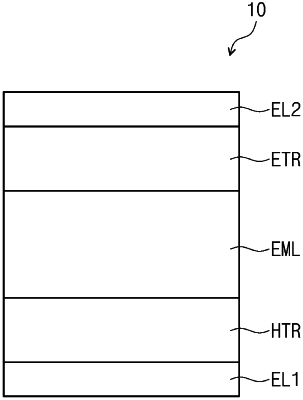
|
1. An organic electroluminescence device comprising:
a first electrode;
a second electrode facing the first electrode; and
a plurality of organic layers disposed between the first electrode and the second electrode,
wherein at least one organic layer of the plurality of organic layers comprises a first compound represented by Formula 1, a second compound represented by Formula 2, and a third compound represented by Formula 3:
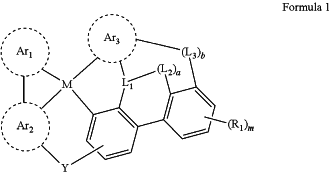 wherein, in Formula 1,
M is Pt, Au, Pd, Cu, or Ag,
Y is O or S,
Ar1, Ar2, and Ar3 are each, independently from one another, a substituted or unsubstituted aromatic hydrocarbon group of 6 to 30 ring-forming carbon atoms, or a substituted or unsubstituted aromatic heterocycle of 2 to 30 ring-forming carbon atoms, and Ar1 comprises, as a substituent, an aryl group substituted with at least one of a hydrogen atom, a deuterium atom, a substituted or unsubstituted alkyl group, a cyano group, a substituted or unsubstituted aryl group, a substituted or unsubstituted alkyl group, and a substituted borazine group,
L1 is a direct linkage or N,
L2 is a direct linkage,
L3 is a substituted or unsubstituted alkylene group having 1 to 30 carbon atoms,
a is 0 or 1,
b is an integer of 0 to 2,
R1 is a direct linkage, a hydrogen atom, a deuterium atom, a substituted or unsubstituted aryl group having 6 to 30 ring-forming carbon atoms, or a substituted or unsubstituted heteroaryl group having 3 to 30 ring-forming carbon atoms, or is bonded to an adjacent group to form a ring, and
m is an integer of 0 to 4,
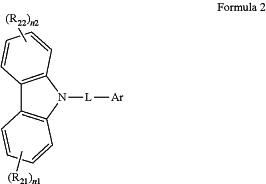 wherein, in Formula 2,
Ar is a substituted or unsubstituted silyl group, a substituted or unsubstituted aryl group of 6 to 30 ring-forming carbon atoms, or a substituted or unsubstituted heteroaryl group of 3 to 30 ring-forming carbon atoms,
L is a direct linkage, a substituted or unsubstituted arylene group having 6 to 30 ring-forming carbon atoms, or a substituted or unsubstituted heteroarylene group having 3 to 30 ring-forming carbon atoms,
R21 and R22 are each, independently from one another, a substituted or unsubstituted aryl group having 6 to 30 ring-forming carbon atoms, or a substituted or unsubstituted heteroaryl group having 3 to 30 ring-forming carbon atoms, or are bonded to an adjacent group to form a ring, and
n1 and n2 are each, independently from one another, an integer of 0 to 4,
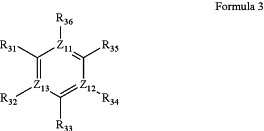 wherein, in Formula 3,
R31, R32, R33, R34, R35, and R36 are each, independently from one another, a hydrogen atom, a deuterium atom, a cyano group, a substituted silyl group, a substituted or unsubstituted aryl group having 6 to 30 ring-forming carbon atoms, or a substituted or unsubstituted heteroaryl group having 3 to 30 ring-forming carbon atoms, or are bonded to an adjacent group to form a ring, and
Z11, Z12, and Z13 are each, independently from one another, C or N.
|
|
16. An organic electroluminescence device comprising:
a first electrode;
a second electrode facing the first electrode; and
a plurality of organic layers disposed between the first electrode and the second electrode,
wherein at least one organic layer of the organic layers comprises a first compound represented by Formula A or Formula B, a second compound represented by Formula 2, and a third compound represented by Formula 3:
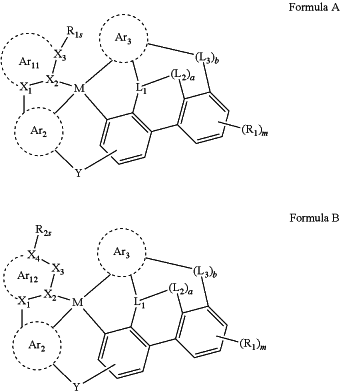 wherein, in Formula A and Formula B,
M is Pt, Au, Pd, Cu, or Ag,
Ar11, Ar12, Ar2, and Ar3 are each, independently from one another, a substituted or unsubstituted aromatic hydrocarbon group of 6 to 30 ring-forming carbon atoms, or a substituted or unsubstituted aromatic heterocycle of 2 to 30 ring-forming carbon atoms,
X1, X2, X3, and X4 are each, independently from one another, N or C,
Y is O or S,
R1s and R2s are each, independently from one another, an aryl group substituted with at least one of a hydrogen atom, a deuterium atom, a substituted or unsubstituted alkyl group, a cyano group, a substituted or unsubstituted aryl group, a substituted or unsubstituted alkyl group, and a substituted borazine group,
L1 is a direct linkage or N,
L2 is a direct linkage,
L3 is a substituted or unsubstituted alkylene group having 1 to 30 carbon atoms,
a is 0 or 1,
b is an integer of 0 to 2,
R1 is a direct linkage, a hydrogen atom, a deuterium atom, a substituted or unsubstituted aryl group having 6 to 30 ring-forming carbon atoms, or a substituted or unsubstituted heteroaryl group having 3 to 30 ring-forming carbon atoms, or is bonded to an adjacent group to form a ring, and
m is an integer of 0 to 4,
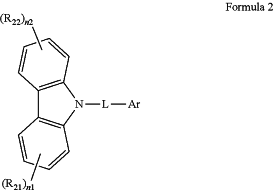 wherein, in Formula 2,
Ar is a substituted or unsubstituted silyl group, a substituted or unsubstituted aryl group of 6 to 30 ring-forming carbon atoms, or a substituted or unsubstituted heteroaryl group of 3 to 30 ring-forming carbon atoms,
L is a direct linkage, a substituted or unsubstituted arylene group having 6 to 30 ring-forming carbon atoms, or a substituted or unsubstituted heteroarylene group having 3 to 30 ring-forming carbon atoms,
R21 and R22 are each, independently from one another, a substituted or unsubstituted aryl group having 6 to 30 ring-forming carbon atoms, or a substituted or unsubstituted heteroaryl group having 3 to 30 ring-forming carbon atoms, or are bonded to an adjacent group to form a ring, and
n1 and n2 are each, independently from one another, an integer of 0 to 4, and
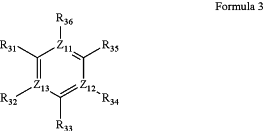 wherein, in Formula 3,
R31, R32, R33, R34, R35, and R36 are each, independently from one another, a hydrogen atom, a deuterium atom, a cyano group, a substituted silyl group, a substituted or unsubstituted aryl group having 6 to 30 ring-forming carbon atoms, or a substituted or unsubstituted heteroaryl group having 3 to 30 ring-forming carbon atoms, or are bonded to an adjacent group to form a ring, and
Z11, Z12, and Z13 are each, independently from one another, C or N.
|